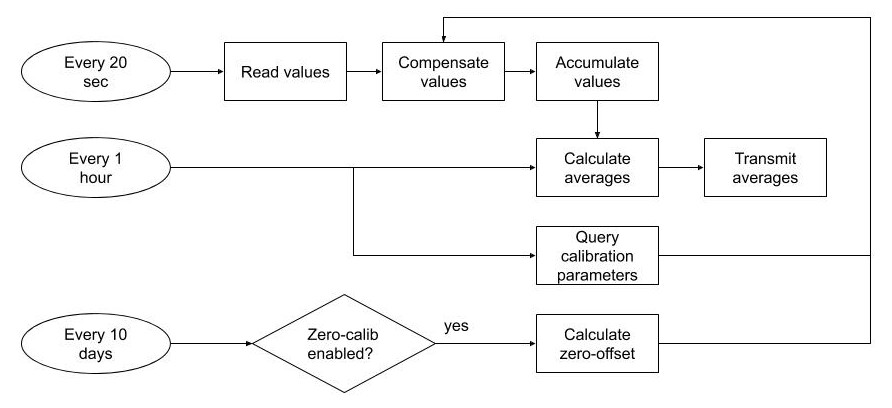RESPIRA FIWARE
Index of contents
The RESPIRA FIWARE station
The RESPIRA hardware follows a simple architecture. An ESP32 SoC acts as the brain of the environmental station. Ambient temperature, relative humidity, NO2 concentration and particle matter (PM) are read from three external sensors via I2C and UART. The ESP32 has sufficient space in flash and horsepower to internally store and process readings in order to filter levels and periodically run some calibration routines. Finally, processed information is transmitted to the FIWARE platform via a HTTP UltraLight 2.0 request.
Specifications
- Parameters provided: Temperature, humidity, NO2, PM1.0, PM2.5, PM4.0, PM10, typical particulate size and CAQI
- Power supply : 5.0VDC
- Maximum current consummed : 300 mA
- Communication : WiFi 2.4GHz
- FIWARE protocol: UltraLight 2.0 HTTP
Working flow
RESPIRA stations read environmental values every 20 seconds. This information is stored in order to get the arithmetic mean every hour and then transmit averages to the IoT platform. RESPIRA stations transmit then average values every hour.
On the other hand, RESPIRA stations also run some internal compensation algorithms based on temperature and some other calibration methods explained here.

Components
RESPIRA FIWARE is formed by two main blocks. The first block is the microcontroller unit, the core of the solution containing the ESP32 board and and the necessary connectivity. The second block is the sensing element, a pagoda-style enclosure containing the environmental sensors. Both main components communicate between them via UART and I2C.
Microcontroller unit
This board relies only on “through-hole” (THT) components in order to simplify the assembly and let the community build RESPIRA stations on basic prototyping boards. As result, we have then chosen an ESP32 NodeMCU board as the ESP32 core. This board not only contains an ESP32 SoC but also a USB interface, used to program and debug the SoC, an on-board 3.3 VDC PSU and a couple of push buttons to manually put the board in programming mode.

The microcontroller board fits into a FIBOX TEMPO TAM131007 box on the left side whilst keeping the right side of the enclosure free in case the user decides to add connectivity for some additional sensors or even place a 5VDC power supply.
Sensors
Sensors are assembled into a pagoda-style enclosure in order to achive the best passive ventilation. We have chosen for this project the TFA-Dostmann 98.1114.02 enclosure, usually available on Amazon.
RESPIRA relies on three external sensors, which have been retained for their accuracy, stability and communication capabilities.
SI7021 Temperature and Humidity sensor
This IC made by Silicon Labs is an exceptional dual temperature-humidity sensor that can be operated via I2C. There are lots of Arduino libraries for this sensor and is also available in form of breakout board so that there is no need to do any surface soldering. These boards are available on eBay and Aliexpress for less than 4 EUR.

SPS30 Particulate Matter sensor
SPS30 is an advanced compact particulate matter sensor designed and manufactured by Sensirion. It is capable to detect particles from 0.5 to 10 microns, calculate concentration for each diameter and even calculate the total mass per diameter. SPS30 features a small package (41x41x12mm) and provides connectivity via UART and I2C. SPS30 is available on Mouser and Digikey for around 40 EUR in small quantities.

The following parameters are obtained from the SPS30 sensor:
- Concentration of PM1.0, PM2.5, PM4.0 and PM10
- Total average size of particules detected
ES1-NO2-50 NO2 sensor
ES1-NO2-50 is an electrochemical NO2 sensor sensible in the 0 to 50 ppm range. Of course we dont need that full range but the sensor performs quite well in low concentrations of gas. Moreover, the zero drift is minimum and the sensor comes calibrated from factory. In order to simplify the integration of this tiny sensor, it can be plugged onto a TB600 board, which does all the complex analog transformations and provides a clean digital reading via UART.

ES1-NO2-50 and TB600 are manufactured by ECSense and can be purchased from Pewatron, the official distributor of ECSense in Europe. Price is around 120 EUR for single quantities.